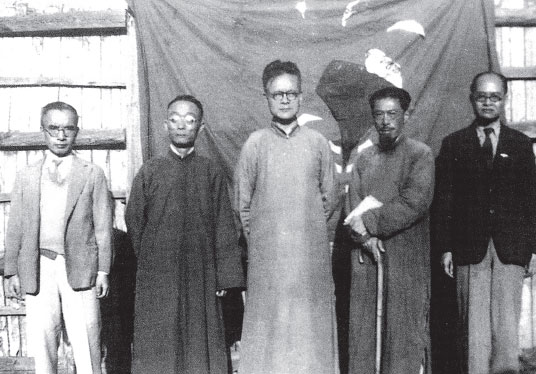Scholars protected nation's wartime education
By Bai Xu China Features (China Daily) Updated: 2015-08-25 07:44
|
Wen Yiduo (second from right) poses with other professors of the Chinese literature department at National Southwest Associated University in 1944. The university was created by Peking University, Tsinghua University and Nankai University in 1937 to move higher education away from wartime hostilities in occupied China. Photo Provided by China Features |
"My life would be far different otherwise," said the 92-year-old retired civil servant in Beijing.
"If a bombing occurred within the first hour, the exam was invalid. If it was within the second hour, the score still counted," he recalled.
Under the threat of bombardment, he completed his exams to enroll at a university in the southwestern city of Chongqing. Shortly afterward, he was accepted by the history department of National Southwest Associated University.
Unbeknown to him, he was signing up for one of the country's greatest scholarly legacies.
An alliance among Peking University, Tsinghua University and Nankai University during the war, NSAU was formed after the decision to move the universities southward in 1937.
Over eight years in Hunan and Yunnan provinces, Chinese masters in all subjects gathered at NSAU, producing two future Nobel Prize laureates and eight scientists who were to work on the atomic bomb.
"The university trained many talented people who later contributed to building New China after Japan was defeated," Hu said.
"The eight-year war against Japanese aggression didn't stop college education in China. It was a miracle."
The odyssey
The journey south was rigorous. The three universities first moved 1,500 km from Beijing to Changsha, capital of Hunan province.
"It was not an easy decision to move out of Beijing and Tianjin," said Chen Pingyuan, a scholar from Peking University who spent years researching NSAU.
"In the flames of war, some scholars left their families, some abandoned their collections."
More than 1,000 students walked the entire distance carrying documents and scientific instruments, begging for food along the way.
University classes began on Nov 1, the day Japanese fighter planes first appeared in the sky over Changsha.
A year later, Japanese aggression forced the professors and students to move again. This time they were bound for Kunming, capital of Yunnan province.
The 1,350-kilometer odyssey started in February 1938, according to the diary of Wen Yiduo, who was a poet and a literature professor at Tsinghua University.
"We spent 68 days on the way, arriving on April 28," he wrote. "The scenery was beautiful, with all kinds of plants and animals, all types of houses and tools, and people dressed in all fashions."
They had to walk 30 to 40 km a day, spending the night in temples, farm buildings or even out in the open.
During the journey, students from different departments conducted research. The sociology students learned about rural China, economics students asked locals about production and livelihood, literature students collected ballads, and geology students examined mines, fossils and rock formations.
Zha Liangzheng, a student from Tsinghua, carried an English-Chinese dictionary on the way. He spent his time memorizing all the entries on a page, tearing pages out to mark progress. When he arrived in Kunming, most of the book was gone.
He later became a poet and translator, translating Don Juan and Eugene Onegin into Chinese, as well as works by W.B. Yeats, Alexander Pushkin and Percy Bysshe Shelley.





